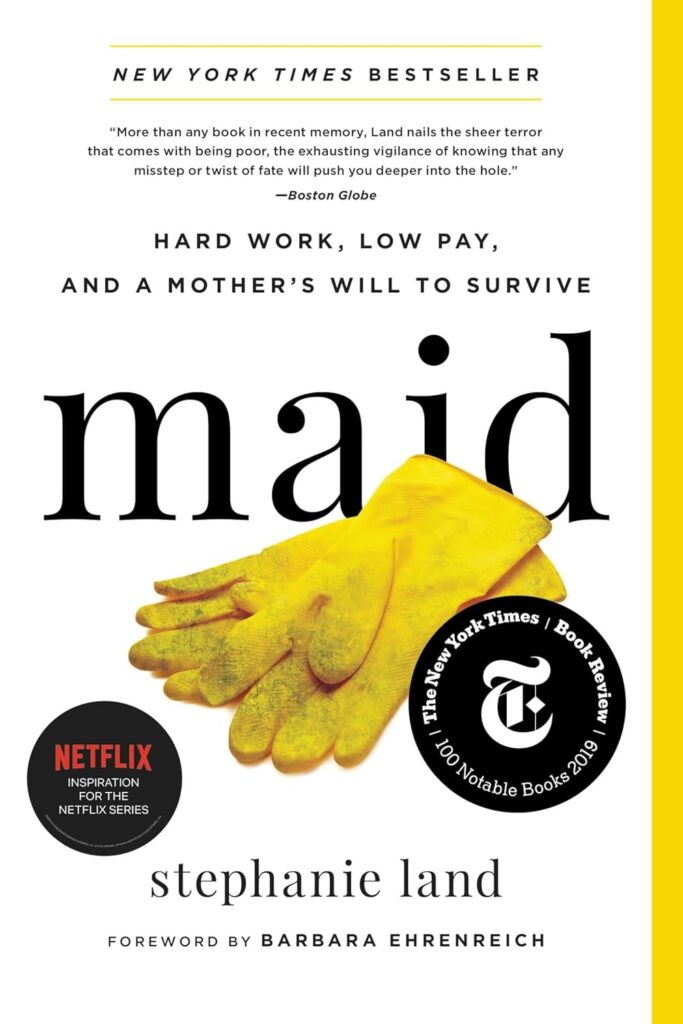Stephanie Land’s Maid: Hard Work, Low Pay, and a Mother’s Will to Survive cuts deep into the realities of poverty in a way that’s both intimate and universal. This isn’t just a memoir; it’s a raw, unfiltered window into a world many people choose not to see. Land’s story gained widespread recognition as not only a New York Times Best Seller but also the basis for the successful Netflix series Maid. But beneath the accolades and adaptations lies a story about grit, survival, and the invisible struggles of the working class.
Stephanie Land’s Journey: Behind the Memoir
You don’t just stumble upon a life like Stephanie Land’s; it unravels slowly, painfully. A single mother forced to balance the endless demands of low-wage work and parenting, Land’s story begins with a dream of becoming a writer—a dream mostly kept alive by sheer will and the belief that words mattered. She worked as a house cleaner to make ends meet, scrubbing toilets and living on food stamps while navigating an unforgiving system that seemed designed to keep her exactly where she was.
Land’s decision to write Maid wasn’t just about telling her story but about shining a light on the economic struggles millions endure silently. Through this work, her voice became a rallying cry for those who are unseen and unheard. Stephanie Land’s journey is one of strength, persistence, and speaking truth to a society often blind to its own inequities.
For more insight into Land’s journey, consider this excellent review from The Social Worker, which delves into her experiences.
Core Themes and Insights from Maid
Land doesn’t just tell us about her life; she makes us feel it. With each chapter, we’re drawn into the core themes of her narrative—poverty, systemic barriers, the invisibility of domestic labor, and the often awkward, fraught dynamics between employer and employee. These themes aren’t just theoretical; they’re woven into every moment of her life.
The Emotional and Physical Toll of Poverty
Imagine being so exhausted that even sleep doesn’t help. That’s the kind of weariness Land describes. Poverty is insidious—it creeps into your bones, your relationships, your sense of self-worth. Through vivid anecdotes, Land captures how her work as a maid wasn’t just physically draining but emotionally suffocating. She cleaned homes for people who barely acknowledged her existence, all while worrying about whether she’d have enough money to buy her daughter’s next meal.
This is a recurring theme that resonates with anyone who’s ever felt stuck in an endless loop of working just to get by. If you’d like further analysis, this Goodreads review offers a closer look at the emotional depth of Land’s storytelling.
The Complexities of Social Assistance Systems
Here’s the thing about safety nets—they often come with holes. Land’s experiences navigating welfare programs, food stamps, and subsidized housing reveal a system that’s as humiliating as it is necessary. The irony? The very programs designed to help people are so mired in bureaucracy and judgment that they often end up doing the opposite.
One of the most poignant moments in Maid is Land’s description of standing in line for food stamps, her dignity eroded by the assumptions people make about “welfare moms.” Yet, she carried on, driven by the need to provide for her daughter. This Reddit discussion offers varied perspectives on this critical theme.
Employer-Employee Relationships in Domestic Work
The relationship between a maid and her employers is, at its best, awkward. At its worst, it’s downright dehumanizing. Land paints a vivid picture of cleaning homes for people who didn’t acknowledge her presence or assumed she wasn’t paying attention. She was both intimately connected to and completely separate from the families whose homes she scrubbed.
It’s an unspoken battle between roles: the maid who sees too much and the employer who sees too little. Land captures this dynamic in a way that’s both chilling and familiar to anyone who’s ever felt unseen in their labor. You can read more about this complicated relationship in this in-depth review by Bookish Wayfarer.
Reception and Critiques of Maid
Readers and critics alike have praised Maid for its unflinching honesty, though not without some criticism. On the one hand, it’s celebrated for shedding light on poverty in America, giving a voice to those who feel invisible. On the other hand, some have argued that the memoir occasionally lacks self-awareness, portraying Land herself in ways that feel distant or repetitive.
Yet, maybe that’s part of its power. Life is messy, emotional, and repetitive—especially when you’re trying to survive. Maid doesn’t try to tie it all up in a neat bow, which is part of what makes it so compelling.
The Netflix Adaptation: Maid on Screen
The Netflix adaptation of Maid, starring Margaret Qualley, takes Land’s story and transforms it into a visual tapestry of struggle and resilience. The show doesn’t shy away from the grueling day-to-day realities Land faced, but it also takes creative liberties, shaping her journey into a narrative fit for television.
Key Differences Between the Book and the Show
While the book is rooted in Land’s specific experiences, the show broadens its focus, giving a more dramatized account of poverty and domestic violence. Some characters are composites, and events are altered to fit the pacing of a TV series. But what remains constant is the raw emotional core.
The show employs unique visual techniques, like showing Alex’s dwindling bank balance on-screen, to hammer home the precarity of her situation. You can read more in-depth analysis of the Netflix adaptation at The Guardian.
Public Reception of the Netflix Series
Audiences embraced Maid for its heartfelt performances, particularly Margaret Qualley’s portrayal of Alex. The show’s ability to balance heaviness with moments of hope struck a chord with viewers. It’s estimated that over 67 million households streamed it within its first month—a testament to the universal appeal of this story. Critics like Roger Ebert lauded the show for its honesty, though some felt it leaned too heavily on dramatization.
Conclusion
“Maid” is more than a book or a show; it’s a mirror reflecting back the realities of poverty and inequality. Stephanie Land’s story has sparked conversations about labor, privilege, and what it truly means to struggle. Whether through her memoir or the Netflix adaptation, her work will continue to serve as a poignant reminder of the strength it takes to survive—and the changes we need to make as a society to ensure no one has to fight that hard just to break even.

